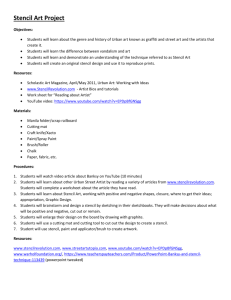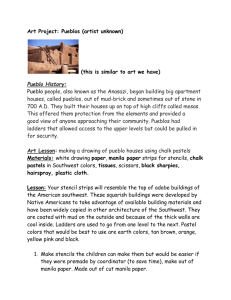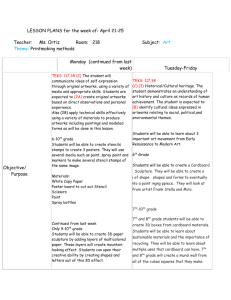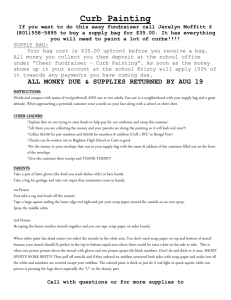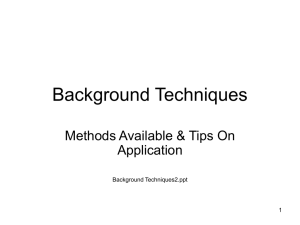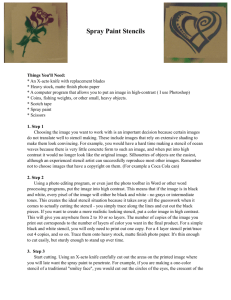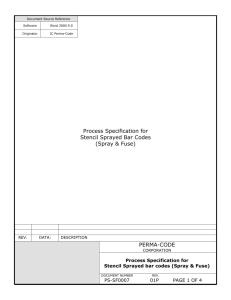PDF - The Public Studio
advertisement
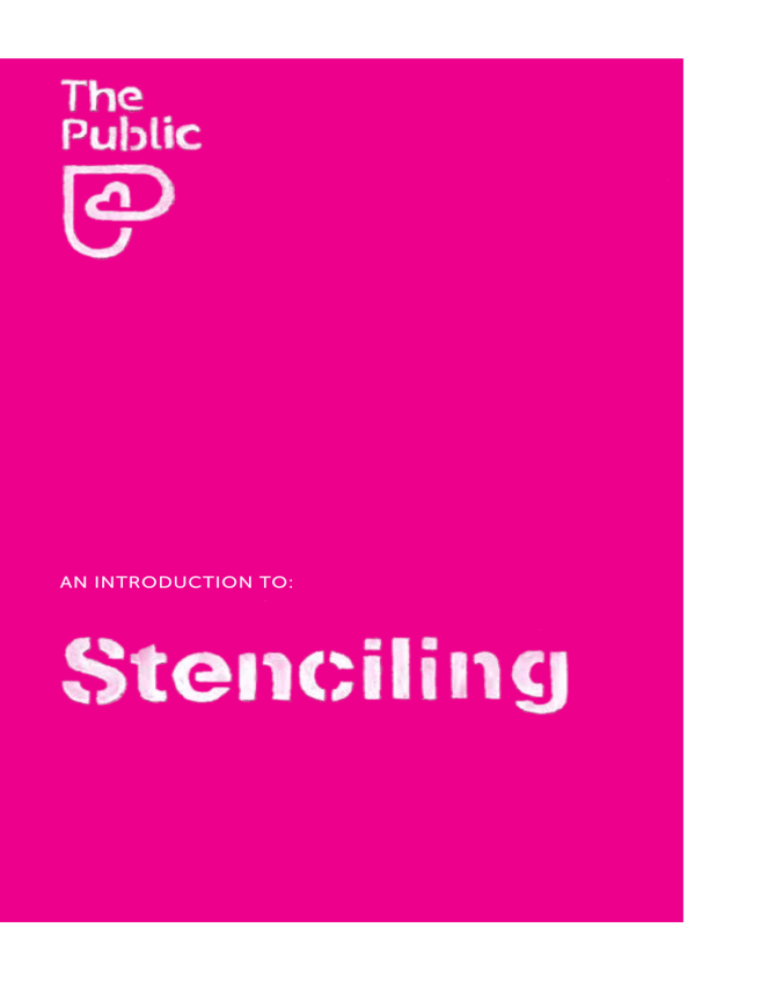
AN INTRODUCTION TO: Contents The Public is an activist design studio specializing in changing the world. This zine, a part of our Creative Resistance How-to Series, is designed to make our skill sets accessible to the communities with whom we work. We encourage you to copy, share, and adapt it to fit your needs as you change the world for the better, and to share your work with us along the way. Special thanks to Helén Marton from the YorkSheridan Design Program in Toronto, for developing this zine on behalf of The Public. For more information, please visit thepublicstudio.ca. This work is licensed under the Creative Commons AttributionNonCommercial-ShareAlike 3.0 Unported License. To view a copy of this license, visit http://creativecommons.org/licenses/by-nc-sa/3.0/. About our internship program Introduction 4 What you want to say and how you want to say it Things to consider Worksheet 6 7 8 Idea Generation Image, text or both Free sketching Brainstorming Internet search 10 10 10 12 12 Cut & Dry: the ins and outs of stencil making Materials Materials checklist Design Typography tips Image tips Using colour Surfaces to apply stencils on Step-by-step guide 14 14 16 18 20 22 22 24 25 Selected resources Books Fonts Images and inspiration Tutorials 30 30 30 30 30 The ready-to-use stencil inserts are located in the middle of the booklet. Stenciling is an easy, effective and accessible way to communicate your message to a lot of people. The technique will allow you to create and distribute compelling graphics in the public sphere, regardless of your experience or budget. Stenciling requires no specialized materials and is ideal for fast and cheap reproduction. This zine will help you to think about what you want to say and how you want to say it, familiarize you with various stenciling techniques and materials and lead you through the process with a step-by-step guide. We’ll also provide you with plenty of resources to check out along the way. Feel free to share this zine with your community and share the results of your work with us at The Public! We can’t wait to Connecting with the community... Whether it is racism, patriarchy or austerity you’re fighting, chances are there are others working to resist the same things. It’s always a good idea to get informed and inspired by others’ work and to educate yourself on the movement you are supporting. -4- images from MacPhee’s book titled “Stencil pirates” Introduction see how you’ll use this exciting technique to change the world. Because stenciling is so accessible and easily allows for large-scale distribution it has historically played a central role in the Because stenciling is so accessible and easily allows for large-scale distribution it has historically played a central role in the spreading of important messages. spreading of important messages. The technique was invented thousands of years ago, when there were no photocopiers or printers to reproduce images and text, and grew in popularity in the 20th century as many of the household items required for stenciling became more common. Stenciling played a central role in the art for many resistance movements between 1960 and 1980 in France, South Get inspired! Check out these links for more information on history and examples: • radicalgraphics.org • anti-war.us • squartzine.info • protestgraphics.org • stencilarchive.org • wikipedia.org/wiki/ Stencil_graffiti Africa, Nicaragua and Germany (to name a few). The rest, as they say, is history. Today stenciling remains a popular tool for political expression. Ready? It’s time to get creative, experiment, get (a little) messy and start stenciling! -5- Defining your message Stenciling allows the freedom to accommodate virtually any message, because you can fully control what images and words appear on your stencil. The sky’s the limit! We encourage you to experiment freely with the techniques: see what works, what feels right and what doesn’t. But, if you have a specific goal (Call attention to street harassment? Make people think critically about public space?), it’s always helpful to map out your message and ask yourself a few simple questions to help your project reach the right people in the right way. Below is a list of questions to consider and a worksheet to help shape your message, define the parameters of your project and keep you organized. Things to consider: What are the resources you have available for this project? Think about your budget, timeconstraints and people-power from start (planning, stencil -6- images from MacPhee’s book titled “Stencil pirates” What you want to say and how you want to say it making) to finish (applying stencils/distribution). What kinds of communities and groups can you connect or collaborate with to help bulk up those resources? Space for notes What are your goals and objectives? What are you working towards? Think about what you’d like people to do when they encounter your work (is there a call to action?). Are you looking to raise awareness? Get people involved with a bigger initiative? Affect emotions? Consider your target audience and what they might listen to. What is in their power to do? Who is your target audience? What are their characteristics? How do they currently think about things, and how would you like that to change? What might change their minds? What is the content of your message? Try to sum it up in a slogan, or short sentence. If it works with your goal, it can later be paired with a punchy symbol or image to be stenciled. Is there an image, or symbol that you can think of that is in some way symbolic of the cause/ message? Sketch it! Don’t worry if it looks very rough at this stage. Also, make sure to consult the image resources on page 5 for some inspiration, middle of the booklet for ready to use stencils, as well as the “image tips” section on page 22. Where will the stencil go? Walls? Posters? Banners? T-shirts? Consider what audience are you trying to engage and what outlet makes the most sense for them and for your message. It is also possible to have more than one outlet — don’t hold back! -7- Worksheet Space for notes, sketches Tone: Space for notes, sketches HOW DO YOU WANT IT TO AFFECT PROJECT YOUR AUDIENCE? Budget: HOW MUCH DO YOU HAVE TO SPEND? ! Timeframe: Launch date: ? Other: IS THERE AN EVENT OR OCCASION YOU ARE PREPARING THE STENCIL FOR? LEAVE EXTRA TIME FOR EXPERIMENTATION AND TRIAL-AND-ERROR. Explain briefly: Goals and objectives: WHAT WOULD YOU LIKE TO ACHIEVE? Message and content WHAT DO YOU WANT TO SAY? Target audience and relevant characteristics: WHO IS YOUR MESSAGE FOR? Distribution WHAT IS YOUR OUTLET? Surfaces to stencil: Where? -8- -9- Idea generation It can sometimes feel intimidating to start a creative project, but no need to worry, this section is here to guide you through the process and introduce you to a couple of techniques to loosen you up and get those creative juices flowing. Remember, there is no such a thing as a bad idea! A seemingly bad idea can help you see an issue from a different perspective, inspire an idea you’re more excited about and can even turn into a brilliant one with some tweaking. Stay positive, and don’t restrict yourself. Text, image OR BOTH? Depending on your message and cause, an image or text, or a combination of both might work better. Try different combinations, and see what makes the most sense! Are your images and text saying two different things? Are they saying the same thing? Does this help communicate your message? Text Allows for less misunderstanding, but brings less attention to itself. It may also communicate to fewer people depending on language choice and literacy. - 10 - Get inspired online! Ready to use stencils: • stencilrevolution.com/ stencils/ • stencilry.org/stencils/ Get sketching! Inspiration, and images to be turned into stencils: • radicalgraphics.org • anti-war.us • squartzine.info • protestgraphics.org • stencilarchive.org Image It can hold symbolic power and say more than words can, but it may be easily misinterpreted. Image and text The combination of both image and text can be more powerful than the two elements separately, as it can engage your audience on different levels, but sometimes it can be hard to coordinate the text and image together. FREE SKETCHING This is probably the easiest, most intuitive way to get started. What is that comes first to mind? What shapes, words, and symbols do you think of when thinking of the cause you are fighting for? Sketch them here, or a scrap piece of paper. - 11 - Brainstorming Brainstorming is a great technique to expand your thinking, and get “unstuck”. Start by writing down your message or cause in the centre circle on the right. Now, free-associate and write down words or sketch all images that come to mind. Nothing’s off limits! Keep repeating with each sub-idea and remember not to restrict yourself. You are essentially following a creative train of thought, and creating a map that consists of free associations relating to your concept. From this map you can then get inspiration for images or words to use for your stencil! Again, don’t forget that there is no such a thing as a bad idea, and write down everything you can think of! Start brainstorming here! your main concept goes here! Internet search If you have access to a computer, googling is great way to get inspired and see what solutions other people came up with. See what the image search brings up! After you’ve tried a couple of these techniques, narrow down your ideas to the ones you like most, and look at your worksheet on page 8. Reviewing your goals will help you edit, and see which solution aligns best with your original plan. Once you have something you think meets your - 12 - - 13 - goals, it is a great idea to show it to people: ask friends or community members to look at your design and ask for their opinion. Listen to what they have to say about it and see if you are getting the reactions you were hoping for. If your message doesn’t quite get through, you can review or re-think it before making the stencil and distributing it all over town. Cut & dry: the ins and outs of stencil-making Materials Let’s think about some basics before all the materials: • How many times do you want to reproduce the graphic? 1? 10? Million? Consider your goals, distribution outlet and budget. • What materials will you need? Consider your budget, distribution sites/method. Stencil form • paper (manila file folders, cardboard, bristol boards etc.) OR plastic (acetate or other sheets of plastic, ask for acetate, duralax or overhead sheets found in art supply stores) - 14 - Paper or plastic? Choosing your stencil material. Paper is ideal for larger and simpler graphics, and can be very inexpensive, especially if you use found cardboard or recycled file-folders. If the paper is too thick, it may be hard to cut through (so think about your graphics!), and if too thin, it may absorb some of the paint and soak through to the application area. If you are planning to use a stencil more than 5-10 times, consider plastic instead, as it will last longer than paper. While it may require a trip to your local art supply store, and is a bit less friendly to the planet, plastic is ideal for more complex graphics as it is easier to cut. You can also use old x-ray prints! It is recommended for productions that reproduce graphics more than 5-10 times, as it is more durable than paper and can be stored well for future use. Tools for cutting the stencil • exacto knife (recommended) OR scissors if what you cut is soft enough and you don’t have a highly detailed image • image (more about this in the image section, page 22) • ruler (if your design contains straight edges) • cutting matt or a stack of cardboard to protect the table or surface on which you’re cutting your stencil • masking tape (to secure stencil) • pencil OR pen OR marker (to outline hand-drawn letters and final designs) Painting tools • thick brushes OR sponges (to apply paint on larger areas with less detail) OR paint rollers (best for t-shirts, and pavement) • paper plate, paint tray, aluminum foil (to mix/place paint on if using thick paint) Protect yourself! Protective equipment like rubber gloves and respirators are very important when using spray paint and other paints that are corrosive to health. Also note that in some places there may be an age restriction on buying spray paint, though there’s nothing wrong with teaming up with older folks who may be able to help out. Space for notes Paints The paints will depend on the surface you want to apply the stencil on (consider if you want the piece to be indoors or outdoors): • wood (acrylics, wood stains) • fabric (bleach, fabric paint, acrylics) • glass (use spray paint or permanent markers) • pavement (crushed up chalk, spray adhesive, spray paint) • walls (spray paint) • paper (acrylic, spray paint or watercolour depending on the desired aesthetic effect/thickness of paper) Do some testing on the paper to check if the paint will make the paper wavy. - 15 - materials checklist 1 2 3 a) 4 a) b) 7 5 a) 8 a) b) c) 9 a) b) c) 10 a) b) c) b) c) Paper b) Plastic check off the items here as you gather them! 1. Respirator 2. Gloves 3. a) Paper b) Plastic 4. a) Exacto knife b) Scissors 7. masking tape 5 8. a) Paper plate b) Aluminum foil c) paint tray 9. a) Spray paint b) Acrylic paint c) chalk 5. Ruler 6. a) Pencil b) Pen c) Marker - 16 - 10. a) paint brush b) Sponge c) Roller - 17 - fight the STOP OIL war Typeface: stencilia CHANGE! Ready to use stencils for you to cut Ready to use stencils for you to cut images from stencilrevolution.com Design By now, you’ve figured out your imagery and the words you want to use, and it’s time to think about how to translate that to a stencil. Stenciling is fairly straightforward when you understand what makes a stencil work and what would make it fall apart. That’s where the bridges and islands come in. Bridges and islands are worked into the design of the stencil to keep certain parts of a shape out of paint’s way. Take a look at the image on the bottom-right of this page to see what a difference these little islands and bridges make. As both are key in maintaining the integrity and defining the detail of your graphic, they should be kept thick enough so they don’t break in the middle of your project. bridges, taping a toothpick on the front side of the bridge may help prolong its life (see diagram on the next page). Bridges and islands are worked into the design of a stencil to keep certain parts of a shape out of paint’s way. Here is a chart that will help you with determining the thickness of your bridges: Which material are you planning to use? PAPER PLASTIC how many times will how many times will you use the template? you use the template? 1-2 3-5 1-2 5-10 10+ 2 mm ~2 mm ~3 mm ~4 mm ~1 ~1 cm cm Stencil Bridge ~3mm ~5 mm ~3 mm ~1 cm ~1.5 cm ~ Island Enforce your bridge using a toothpick especially if you are using paper and the bridge is thin! There are 3 factors to keep in mind when picking the thickness of the bridge: Toothpick • How many times do you plan on using the stencil? • How large of an area will the bridge connect to and support? • Are you using paper or plastic for the stencil? Stencil print with a bridge Tape Stencil Stencil print without a bridge Tape Follow the flowchart on the next page to determine what thickness you will need. If you have no choice but to have thin - 18 - - 19 - Transferring the design to your stencil Perhaps the easiest way to transfer the design to your stencil is to glue or tape the sheet you planned your design on to the stencil form. You can start cutting the shapes after the glue has dried. Typography tips Do you plan to include text in your design? The choices you make about how the text will look will determine the tone and voice of what you are saying. You can get a font online, or hand-write your message. Most importantly, keep the message legible! Fonts available online There are many fonts available for free on the internet. We have included a list of free font download sites on the next page, or if you don’t have access to a computer, you can photo-copy and cut out the stencils included in the middle of the zine. The easiest fonts to use are the ones that are already designed to look like a stencil (see diagram on the next page). These already incorporate the necessary bridges that you need to make the stencils hold together. With these fonts, all you have to do is type up your message in a program such as Word, print it and then glue it on the stencil to be cut out. You can also use fonts that are not - 20 - specifically designed to imitate stencils, but you will have to do a little work to make sure that you included the bridges so no parts of the letters will end up missing in your design. Again, keep in mind that legibility is key, so it is not advised to have very thinly stroked or wacky fonts, When picking fonts keep in mind how that font influences the tone and voice of what you are saying. as they may not transfer well and will be illegible. A thin, round edged typeface will have a soft, quiet, friendly voice, whereas a thick, geometric font set in allcaps will have a feel of louder, more aggressive speech. Think about how the font you are picking makes you feel. Is this consitent with your desired tone? Does it make sense with your message? Hand-drawn type Hand drawn letters can be very effective and look great, and will not require you to use the computer. This kind of lettering has a humanistic feel, evokes Font conveying an agressive tone: BE ANGRY! Font conveying a lighter tone: Be happy! Find your font! • stencilrevolution.com/ resources/ • dafont.com (search for their stencil font collection) • fontsquirrel.com • losttype.com Font ready to be stencilled: Stencil me! Terminology counters: compassion and might work well with your project if this is the tone and manner that you are going for. However you need to make sure that your writing is legible, and the strokes of the letters are wide enough to be cut and later stenciled. While it depends on your materials and comfort-level wielding a knife, a general rule-of-thumb is to keep the thickness of your lines or open areas over 1cm. One way to ensure proper stroke width is to use a thick marker to write out the letters. Make sure you leave bridges to connect the islands to the main stencil, otherwise you’ll end up with some filled counters (see diagram on the right). You can also alter the tone of your writing by drawing thicker geometric letterforms, thinner rounder ones, and everything in-between. marked with pink below, “Counter” refers to the area partially or fully enclosed by the letter shape abdpoqce Stroke: the line that defines the shape of a letter. thin stroke: A Thick stroke: A Transforming non-stencil fonts into a stencil: identify counters: ACT! mark bridges to secure counter: ACT! - 21 - IMAGE TIPS When you have decided on an image to use, you need to create a drawing that can later be cut out. The easiest way to turn digital images into stencils is to use photo-editing programs such as Photoshop, or GIMP (it’s free!), and to alter the brightness and contrast levels to come up with a black and white image that can be cut into a stencil. Here is a link with specific steps: www. stencilrevolution.com/tutorials/ convert-color-photo-to-stencilphotoshop/. No computer? you can also photocopy the image a couple of times and turn up the contrast so the image will reproduce using 100% black areas and white areas. An even easier way is to have a printout of the image you’d like to use, place tracing paper on top of it and trace over the prominent shapes. Colour them in to see how the stencil will look. Using colour enhance the meaning? Think about the colour of the surface on which you will apply your stencil (you may want to consider darker inks for lighter surfaces or lighter inks for darker surfaces to increase contrast and visibility). Ask yourself how different colours make you feel, and how these feelings work with your message. To use more than one colour on an image, you will have to make separate stencils, to ensure clean edges (see diagram below). Without multiple stencils the colours might mix together and form a new, colour which may take away from your vision. Make two stencils to have a two coloured stencil: Step 1 Ready to use stencils: • www.stencilrevolution.com/ stencils/ • stencilry.org/stencils/ Inspiration, and images to be turned into stencils: • radicalgraphics.org • anti-war.us • squartzine.info • protestgraphics.org • stencilarchive.org/makestencils/ • riniart.org Copyright and Creative Commons license If downloading images off the web, be careful with using copyrighted visuals. If you can, ask the creator for permission, if they would like to be credited in your work and tell them about the nature of your project. Creative Commons is a new and better alternative to the copyright law that allows a work to be copied, distributed, edited, remixed, and built upon while protecting the owner from unfair uses. Artworks marked with symbol signals that you will likely be able to use the work for your stencil. There are different kinds of creative commons licenses, so make sure to double check which one a particular artwork is under and your usage of the work meets the criteria of that specific license. You can find more information about Creative Commons here: creativecommons.org. Step 2 Colour is a great way to add character and volume and to make your work capture even more attention. Consider the message: are there any symbolic colours that can be used to - 22 - - 23 - Surfaces to apply stencils on You can apply paint using a stencil on pretty much any surface, as long as the right paint along with the right stencil is used. Review the materials section on page 15 to make sure you pick the right paints for the right surface. Below are some examples of surfaces you can apply your stencil on. Be sure to note local bylaws so you can make informed choices. 1) Walls When choosing a wall, think about the textural characteristics of the surface you are applying the stencil on. If your stencil is very detailed, the details might get lost on a rough surface. A more environmental friendly alternative to spray paint is applying and growing moss on walls according to the stencil. Follow this link for detailed instructions on the technique: stencilrevolution.com/tutorials/ how-to-make-moss-graffiti/. 2) Pavement For non-invasive and temporary installations you can use chalk powder and non-permanent spray adhesive on the pavement. You can find detailed instruction on the technique here: stencilrevolution.com/tutorials/ guide-to-using-chalk-for-stencils/. - 24 - 3) Paper or plastic Check on a small sample of paper to see if the paint you chose is appropriate. Some paint might soak through thinner paper and make the surface undesirably wavy. . 4) Textiles You can use textile paint, spray paint, or even bleach to leave marks on textiles. You can find a tutorial on how to stencil on fabric using bleach here: stencilrevolution.com/tutorials/ bleach-fabric-guide/. STep-by step guide The stencil used in this gUIde is from stencilrevolution.com 1) Fill out the worksheet provided on page 8 if you haven’t already done so. 2) Generate your ideas, ask peers, decide on your best design (see the idea generation section on page 10). 3) Clear working area, place a protective layer, such as a cutting matt on the desk, table or floor. 4) Get and prepare all the tools that you will be needing (refer to materials list on page 16). Potential application of stencils • banners • flags • postcards • book inserts • labels • T-shirts • tote bags • flyers 5) Prepare the appropriate text and/or image to be stenciled. Read notes under the Design, Typography and Image tips (pages 18, 20 and 22 respectively). - 25 - 6) Decide on the necessary bridges and mark them on the design. 8) Using a ruler if necessary, cut out the intended shapes, make sure to leave the bridges thick enough and intact. If a bridge is thin, and going to be bearing a lot of weight, make sure to support it with a taped on toothpick (taped to the front of the design) see diagram on page 19. 7) Glue your design on the paper or plastic that will serve as your stencil. 9) Prepare appropriate paint and brushes as well as gloves and respirators if applicable. - 26 - - 27 - 10) Test stencil on paper (old newspaper will do!) to see all shapes are clean and as desired. If it doesn’t leave a clean mark, you can adjust your edges and shapes using an exacto knife to cut off the excess that’s making the mess. 13) Apply paint. 14) Lift off the stencil with care. 11) Prepare the surface to apply the stencil on (clean, dry, see page 15 for more tips and specifics of each surface). 12) Place and secure the stencil with tape onto the surface. 15) Allow the paint to dry. 16) Place another stencil on the design carefully, apply another colour (when applicable). 17) Clean up tools and area. Your stencil is complete. Now pass it on! - 28 - - 29 - Selected resources BOOKS look for them in your local public library! • The Street Art Stencil Book by Olly Walker from Ollystudio (for ideas, examples, stencils and history) • Reproduce and Revolt by Soft Skull press, Brookyn (for lots of political examples, history and tips) • Stencil Pirates by Josh Macphee (for history, ready to cut stencils, and examples in context) • Signs of Change by Dara Greenwald and Josh Macphee (history of social movements, lots of visual inspiration) • Stencil Nation by Russel Howze (for inspiration and lots of tips) FONTS • www.stencilrevolution.com/resources/ • dafont.com/ (look at their stencil font collection) • fontsquirrel.com • losttype.com STENCILS AND INSPIRATION • www.stencilrevolution.com/stencils/ • stencilry.org/stencils/ • radicalgraphics.org • anti-war.us • squartzine.info • protestgraphics.org • stencilarchive.org/make-stencils/ TUTORIALS Tutorials on how to bleach fabric, photoshop, chalk stenciling and more: • www.stencilrevolution.com/tutorials/ • stencilry.org/main/index.php/tutorials/ - 30 -
